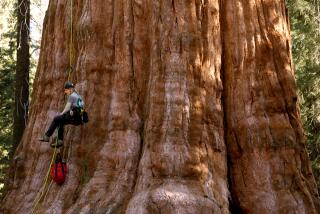Tree Truths
- Share via
There are more than 2,500 species of palm trees, providing a dizzying variety of sizes, shapes and textures. Although usually found in warmer, tropical climates, some can survive as far north as Vancouver, Canada, and at elevations of more than 4,000 feet.
Other facts:
Resilience: While most trees snap in half during hurricanes, palms are structured to withstand them by swaying with the wind, rather than staying rigid. “Their root system is very resilient and rubbery, and the trunks bend,” says Gary Wood, former head of the International Palm Society’s Southern California branch.
Oldest: Some species of palms, such as the double coconut found in the Seychelles Islands in the Indian Ocean, have lived as long as 800 years or more. Others go through a single flowering cycle within 30 years and die when finished. Until the California redwoods were discovered, palm trees were thought to be the oldest and tallest trees on Earth, Wood says.
Tallest: Members of the ceroxylon genus, which grow thousands of feet above sea level in the Andes, can reach heights of 200 feet.
Thickest: The trunk of the Chilean wine palm, or Jubaea chilensis, can get as thick as 5 feet or more but grows slowly, taking up to 100 years to reach maturity. A South American native, it can grow in California but not climates that are too hot, like Florida.
Products: Palm trees provide numerous commercial products, such as dates, coconuts, timber, oil used in cooking and soap (like Palmolive), and fiber used in brooms and ropes.
Sources: Ralph Velez, Gary Wood, Phil Bergman and “Palms Throughout the World” by David L. Jones (Smithsonian Institution Press, 1998).
More to Read
Sign up for The Wild
We’ll help you find the best places to hike, bike and run, as well as the perfect silent spots for meditation and yoga.
You may occasionally receive promotional content from the Los Angeles Times.






